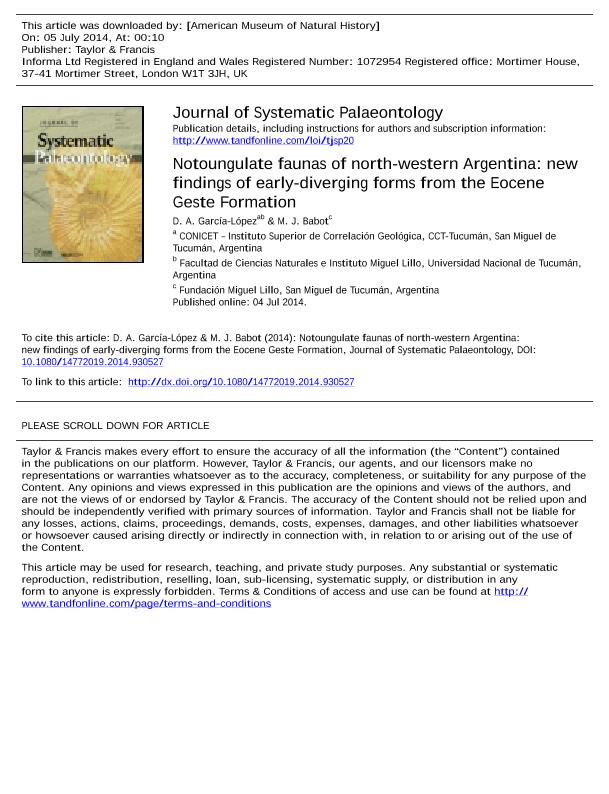Artículo
Notoungulate faunas of north-western Argentina: new findings of early-diverging forms from the Eocene Geste Formation
Fecha de publicación:
02/2015
Editorial:
Taylor & Francis
Revista:
Journal of Systematic Palaeontology
ISSN:
1477-2019
e-ISSN:
1478-0941
Idioma:
Inglés
Tipo de recurso:
Artículo publicado
Clasificación temática:
Resumen
Vertebrate-bearing deposits of the Geste Formation (Late Eocene) crop out in the Puna of Catamarca and Salta, north-western Argentina, and have yielded specimens of a variety of clades. Among these, mammals have particular importance since their record shows some taxonomic peculiarities when compared with that of adjacent units. Here we describe new material that includes Notoungulata of generalized morphology, two morphotypes of basal typotherians, and two interatheriid taxa (including Antofagastia turneri gen. et sp. nov.). These findings increase the variety of groups and provide new information about previously known taxa for this unit. Three phylogenetic analyses with different taxonomic contexts were performed. The first analysis includes the specimen referred to as 'Typotheria indet. A' in a data matrix of Paleogene notoungulates containing taxa traditionally referred as 'Oldfieldthomasiidae'. The specimen is grouped together with three 'oldfielthomasiids' (Maxschlosseria, Ultrapithecus and Dolichostylodon) in the resulting tree. The second analysis involves specimens referred to as 'Typotheria indet. B', 'archaeohyracids', mesotheriids and hegetotheriids. The results show these fossils to be part of a basal polytomy of 'early archaeohyracids'. Finally, a third analysis was conducted with Interatheriidae as the ingroup which recovered Antofagastia turneri at the base of a node including extra-Patagonian forms of non-interatheriine interatheriids plus Eopachyrucos and interatheriines. Although Antofagastia, Punapithecus and Chilean extra-Patagonian forms share some features, such as small size, they do not comprise a distinct clade. The notoungulate record of the Geste Formation shows some singularities in the context of north-western Argentinean Paleogene units, the presence of interatheriids and 'archaeohyracids' being the most striking of these. The differences exhibited can be partially explained by temporal factors, since recent isotopic data points to a Late Eocene age for this unit. Biogeographical isolation represents another possible explanation, because these levels appear to be deposited in an isolated geographical and geological context, suggesting intermontane basin deposition or local wedge-top basins.
Archivos asociados
Licencia
Identificadores
Colecciones
Articulos(CCT - NOA SUR)
Articulos de CTRO.CIENTIFICO TECNOL.CONICET - NOA SUR
Articulos de CTRO.CIENTIFICO TECNOL.CONICET - NOA SUR
Articulos(INSUGEO)
Articulos de INST.SUP.DE CORRELACION GEOLOGICA
Articulos de INST.SUP.DE CORRELACION GEOLOGICA
Citación
Garcia Lopez, Daniel Alfredo; Babot, María Judith; Notoungulate faunas of north-western Argentina: new findings of early-diverging forms from the Eocene Geste Formation; Taylor & Francis; Journal of Systematic Palaeontology; 13; 7; 2-2015; 557-579
Compartir
Altmétricas




